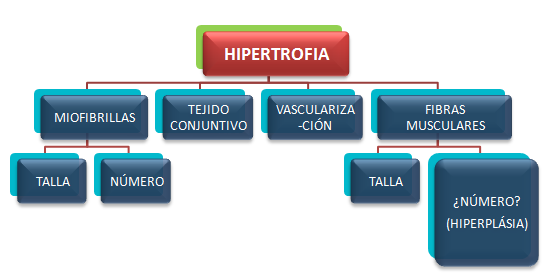ENGLISH
Author: Víctor Llorca Estruch
Author: Víctor Llorca Estruch
In the next post we will talk about the first factor structural strength: hypertrophy.
HYPERTROPHY:
Myofibrils:
Increasing the size of
myofibrils:
It is due to the addition of actin and myosin in the
periphery of the myofibrils.
Increased number of
myofibrils:
• The successive muscle contractions cause
microrrupturas Z bands, forming two "daughters myofibrils".
• It is the main factor leading to hypertrophy.
Connective Tissue:
Not increased contractile tissues such as collagen,
ligaments, tendons and cartilage occurs.
Vascularization:
• The capillaries surrounding the muscle increase in
number.
• With heavy loads (80% -100% 1RM) with minimal
repetitions, down capillaries occurs, although existing has greater volume.
• With submaximal loads (70% 1RM) with many repetitions,
an increased number of capillaries occurs.
Fibers:
Increased fiber size:
• With submaximal loads a hypertrophy of the
intermediate and slow fibers occurs.
• With a lower maximum loads and fast fibers
hypertrophy usually occurs.
Increased number of fibers
(hyperplasia):
• In animals if any, in man is not proven.
Bibliography:
· Class
notes of Theory and Practice of Sports Training. Doctor Claudio
Alberto Casal Sanjurjo. Catholic University of Valencia.
· García Manso, J.M. (1999). La fuerza.
Barcelona: Gymnos.
· González Badillo, J.J., Gorostiaga
Ayestarán, E. (1995). Fundamentos del entrenamiento de la fuerza.
Barcelona: Inde.
ESPAÑOL
Autor: Víctor Llorca Estruch
En el siguiente post vamos a hablar sobre el primer factor
de la fuerza estructural: la hipertrofia.
Miofibrillas:
Aumento del tamaño de
las miofibrillas:
Se debe a una adición
de filamentos de actina y miosina en la periferia de las miofibrillas.
Aumento del número de
miofibrillas:
• Las
contracciones musculares sucesivas provocan microrrupturas de las bandas Z,
formándose dos “miofibrillas hijas”.
• Es el principal factor que provoca la
hipertrófia.
Tejido
conectivo:
Se produce un aumento
de tejidos no contráctiles tales como el colágeno, ligamentos, tendones y
cartílago.
Vascularización:
• Los
capilares que rodean al músculo aumentan en número.
• Con cargas pesadas (80%-100% 1RM) con pocas
repeticiones, se produce un descenso de capilares, aunque los existentes tiene
mayor volumen.
• Con cargas submáximas (70% 1 RM) con muchas
repeticiones, se produce un aumento del número de capilares.
Fibras:
Aumento del tamaño de
las fibras:
• Con
cargas submáximas se produce una gran hipertrófia de las fibras intermedias y
lentas.
• Con cargas máximas se produce una hipertrófia
general menor y de las fibras rápidas.
Aumento del número de
fibras (hiperplásia):
• En
los animales si existe, en el hombre no está demostrado.
Bibliografía:
· Apuntes de Teoría y Práctica del
Entrenamiento Deportivo. Doctor Claudio Alberto Casal Sanjurjo. Universidad
Católica de Valencia.
· García Manso, J.M. (1999). La fuerza.
Barcelona: Gymnos.
· González Badillo, J.J., Gorostiaga
Ayestarán, E. (1995). Fundamentos del entrenamiento de la fuerza.
Barcelona: Inde.








No hay comentarios:
Publicar un comentario